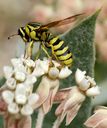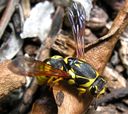Pollen Wasps
Masarinae
Classification
- Phylum: Arthropoda
- Subphylum: Hexapoda
- Class: Insecta
- Order: Hymenoptera
- Superfamily: Vespoidea
- Family: Vespidae
- Subfamily: Masarinae
Pronunciation
How to pronounce Masarinae: //ˌmæsəˈraɪniː//
These audio files are automatically generated. While they are not always 100% accurate, they are a good starting point.
Images


Summary
Masarinae, or pollen wasps, are a unique subfamily of wasps known for their larval diet of pollen and nectar, reminiscent of solitary bees. They construct nests from mud or sand and are particularly diverse in desert ecosystems.
Physical Characteristics
Typically black or brown with contrasting patterns of yellow, white, or red. Antennae are distinctively clubbed; males have elongated antennae ending in a strong club.
Identification Tips
Look for clubbed antennae and two submarginal cells in the forewings. Species may resemble yellow jackets but can be identified by their distinctive antennae.
Habitat
Desert regions of southern Africa, as well as deserts in North and South America; nests are often found under rocks or in crevices.
Distribution
Worldwide; particularly diverse and abundant in desert areas.
Diet
Larvae feed exclusively on pollen and nectar which adults collect and store in their nests.
Life Cycle
Eggs are laid in a mixture of regurgitated pollen and nectar, which serves as provisions for the larvae. After hatching, larvae consume these provisions, pupate, and emerge as adults.
Reproduction
Females build nests, provision them with pollen and nectar, and lay eggs in the food mixture.
Ecosystem Role
Pollinators in their ecosystems; their larvae feed on pollen, influencing plant reproduction.
Evolution
Historically recognized as a separate family, Masaridae, which included other subfamilies; currently classified under Vespidae.
Similar Taxa
- Pseudomasaris
- Vespidae
- Euparagiinae
- Gayellinae
Misconceptions
Often mistaken for yellow jackets due to their appearance, despite significant dietary differences.
Tags
- Masarinae
- Pollen Wasps
- Vespidae
- Insecta
- Hymenoptera